Lattanzio, who was born in Foligno, trained in the workshop of his father, Nicolò di Liberatore, l' Alunno. He was first documented in Foligno in 1480. He collaborated with his father in 1482 for an altarpiece for the rural church of San Giovanni Battista, Cannara.
Lattanzio was active in civic life, serving on the Council of Foligno in 1514, 1516 and 1517. He was last documented in 1527, when he was directing the construction of the Ponte di San Manno.
Foligno
Stigmatisation of St Francis (15th century)
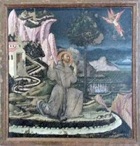
Martyrdom of St Bartholomew (1502-3)
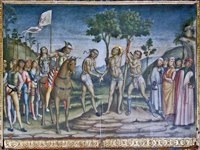
This altarpiece in San Bartolomeo di Marano was commissioned from Nicolò di Liberatore, l' Alunno. A codicil to his will in 1502 records that it was "non ancora perfettamente compiuto" (not yet perfectly complete), and obliged Lattanzio to complete it using materials in their workshop. It depicts St Bartholomew tied to two trees while soldiers flay him alive.
St Mary Jacobi (1507)
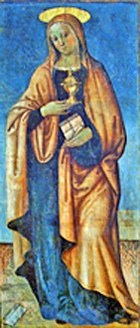
Works in the Pinacoteca Civica
Two works in the Pinacoteca Civica are attributed to Lattanzio di Nicolò:
St Michael (late 15th century)
St Augustine (early 16th century)
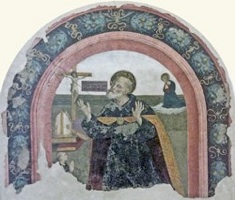
This detached fresco, which is attributed to Lattanzio di Nicolò, came from the nunnery of Sant’ Elisabetta (later in Santa Margherita). It depicts St Augustine in prayer before a Crucifix, with a kneeling monk, presumably the donor.
Assisi
Flying angels (15th century)
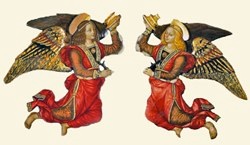
These panels depicting flying angels were intended to hold candles, probably to the sides of a venerated image. They were first documented in the Cappella delle Reliquie of Santa maria degli Angeli in 1872, when they were to the sides of the Crucifix by Giunta Pisano, and they are now in the Museo della Portiuncula there. They are usually attributed to Lattanzio di Nicolò, and some scholars also detect the input of his father.
Perugia
Pietà with saints (early 16th century)
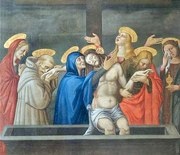
This panel, which now forms part of the Collection of the Fondazione Cassa di Risparmio di Perugia, is attributed to Nicolò di Liberatore and Lattanzio di Nicolò, and might be the Pietà from San Bartolomeo di Marano, Foligno that is mentioned in the will of the latter. It depicts the dead Christ on his sarcophagus with the Virgin and SS Francis, John the Evangelist and Mary Magdalen and two other female saints.
Todi
Predella panels (1491)

These panels formed the predella of a documented altarpiece from Santa Maria delle Grazie, Todi, which was sold in the 19th century. The main panel, which has been lost, apparently depicted a Pietà with the Virgin and St John the Evangelist. The Commune of Foligno bought the predella panels in 1950, and they are now in the Pinacoteca Civica, Foligno.
The surviving documentation includes a receipt signed by Nicolò di Liberatore, l’ Alunno in 1493, acknowledging payment by the Confraternita di Santa Maria delle Grazie for an altarpiece for their church. Nicolò wrote to the brothers in 1494, expressing his intention to return to Todi when it was “free from plague and other tribulations”. It seems that he never returned: in 1504, Lattanzio di Nicolò gave the brothers a receipt for 21 days’ work that he had done while his father was alive (i.e. before 1502), and a bill for subsequent work for the gilding of a tabernacle in the church.
The main panel of the predella depicts for prophets set against a landscape that is reminiscent of the plain of Foligno. The other two panels depict angels holding inscriptions:
-
✴that on the left includes the inscription "Nicolaus Fulginas pinxit: Lattantius filius i(n)auravit" ((Nicholas painted it: his son, Lattanzio gilded it); and
-
✴that on the right gives the date 1491.




